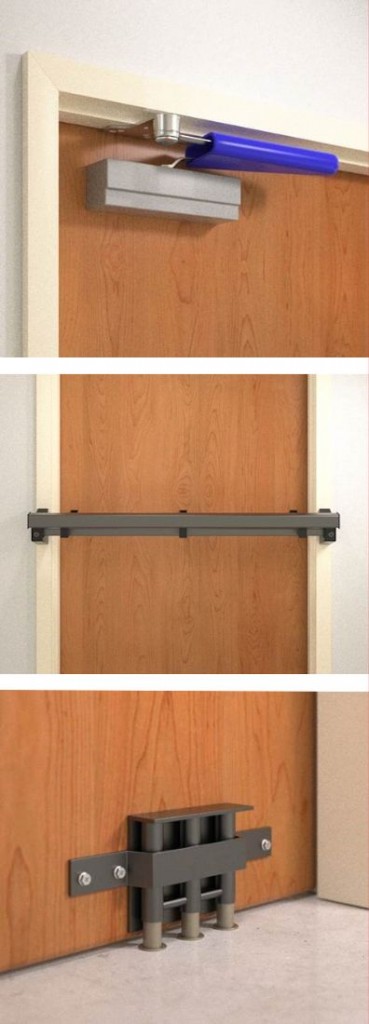 As I have been preparing for tomorrow’s public hearing in Ohio along with members of the door and hardware industry, code officials, and others interested in the classroom barricade issue, I came to a realization: some of the people involved in this debate are not familiar with how barricade devices work.
As I have been preparing for tomorrow’s public hearing in Ohio along with members of the door and hardware industry, code officials, and others interested in the classroom barricade issue, I came to a realization: some of the people involved in this debate are not familiar with how barricade devices work.
This lack of understanding actually makes a lot of sense, because I have to believe that if everyone sitting at the table clearly understood the ramifications of using these products to provide classroom security, there would be more questions, more discussion. The Arkansas legislature would not have voted unanimously to ignore the state fire marshal’s objections and enact a law that allows the devices in schools, with no guidance on where, when, or how they are deployed, or who has access to them.
During the shootings at Virginia Tech , Platte Canyon High and the Amish schoolhouse in Nickel Mines, Pennsylvania, the shooters barricaded the doors with materials that they brought with them. Why would we hang a barricade device next to the classroom door and make it even easier for someone to take hostages and prevent help from intervening? Barricading doors and taking hostages in schools is more common than you might think. A 2007 study called Barricaded Hostage and Crisis Situations in Schools: A Review of Recent Incidents, examined 19 such hostage situations that occurred between 1998 and 2007. In 16 of the 19 cases, the perpetrator was a student at the school – the threat was already in the room.
School districts MUST consider their responsibility to provide a safe environment for students and staff, and their liability if someone is harmed because they fail to do so. Even if a state legislature allows local jurisdictions to override code requirements, jurors may give more weight to established life safety codes than to state legislators when it comes to child safety.
The images at right are not actual manufactured products. They are conceptual examples of barricade devices. No, Allegion is not going into the barricade business. These images were created specifically to illustrate some ways in which a door might be barricaded with a retrofit security product. As you can imagine from the images, many of these devices will securely barricade the door, preventing access from the outside. There are plenty of marketing videos on Youtube showing how difficult it is to get in, even with a battering ram.
If your child was locked in a classroom with someone intending harm, would you want the police spending what could be the last minutes of your child’s life trying to break down the door? Sound far-fetched or extreme? It happened at Platte Canyon High School in Bailey, Colorado. Police were forced to use explosives in order to enter the classroom, and Emily Keyes, a 16-year-old student was shot and killed by the gunman; her family has created iloveuguys.org in her memory. Many police officers are not equipped with the tools or training to quickly defeat a barricaded door, and the time spent attempting to access a classroom could have tragic results.
While the cost of a quick-fix device may seem attractive, the potential for risk is too high. We frequently see the unintended consequences of installing non-code-compliant products, like security bars on windows and double-cylinder (key-operated) deadbolts on exterior doors; people have died because they were unable to escape. Are we willing to extend that risk to the classroom? I hope not.
The barricade graphics with a short summary of the code issues can be downloaded here. If you need high-resolution images or other information, feel free to contact me.
You need to login or register to bookmark/favorite this content.






Excellent Lori! Keep stressing what these people are missing – the crisis is more often IN THE ROOM
Lunchroom discussion on this post:
J: “Yeah, probably designed by a teacher.”
A: “Then teachers design the stupidest door s#&%.”
let’s keep the teachers out of it
Good luck at the hearing tomorrow Lori! They are definitely sending in their best person for the job.
Thanks for continuing to educate administrators and politicians on this very dangerous topic. Keep up the good work, Lori!
Thanks Gretchen!
This is a far more convincing argument against these devices than saying “The Code doesn’t allow them.”
I agree, Sheldon. It’s pretty easy for proponents of the devices to say that the codes are outdated, etc. (even though I disagree), but I have not yet heard a convincing argument about why authorized access from the outside is a bad idea.
Thank you, Lori, for educating us even more on the thoughts that no one thinks of until it’s too late. I appreciate your frankness and please keep spreading the education!